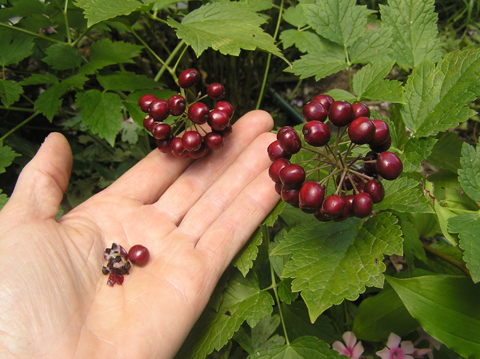 |
| Home | Ordering By Mail | Purchase Manual: Using Native Plants in Urban Landscapes |
|
|||||
Species Name: Actaea pachypoda & Actaea rubra
Common Name: Dolls eye & Red Baneberry
Zone: 2 to 8
Distribution: Actaea pachypoda: eastern Quebec and Ontario south to Georgia, Louisiana and Oklahoma.
Actaea rubra: across northern Canada south to Connecticut and New Jersey.
Seed collection: Fruits mature in late August through September in upstate New York. Baneberry fruit changes color when seed is mature. Red banebery matures a few weeks earlier than Dolls Eye. Red baneberry turns a ruby red color and White baneberry turns porcelain white. Fruit can be collected anytime after the fruit begins to change color. The fruit will remain on the plant for several weeks until it begins to rot.
Seed handling: Harvest fruits after they have changed color. Each fruit contains several seeds. Collecting right after color change may help speed up germination over delaying for a few weeks. Remove seed from the fruits by macerating and floating off the pulp and skins. Sound seed will sink to the bottom. Fruits can be macerated by hand for small batches or use a food processor for larger batches. Sow seeds immediately or begin stratifying the seed for storage. Do not let seed dry out after cleaning.
Germination requirements: Most Actaea seed will germinate the first or second season after harvest. Germination percentages are high, some seed may take one or two additional years. Seed requires a chilling period of one to two months; seed that is sown outdoors in the fall will have their chilling requirement met. Seed that is being stratified should be subjected to outdoor temperatures or placed in the refrigerator for one to two months just before planting. Seedlings germinate in early spring through mid summer. They will develop into small plants by fall. Plant should flower the second growing season.Sow seed on the surface of the soil to ½” deep. Any average to rich soil will do. Under natural conditions, move the leaf litter aside, sprinkle seeds on the soil, then replace leaf litter.
Ecology: Actaea is an easy woodland species to grow and propagate from seed. The fruits are abundant; easy to collect and seed readily germinates. Baneberry grows in part sun to full shade in moist to average woodland soils. It is adaptable to a range of soil and horticultural conditions. Baneberry grows best in rich deep well drained soils. Dolls eye also grows on moderate to dry mixed forests. Circumneutral pH.Actaea makes up a small component of the herb layer where it grows. Sugar maple and Basswood are good tree indicators of where baneberry will grow. Common herb associates are False Solomon seal, Zig zag goldenrod, Blood root and Wild geranium. The two Baneberries are often found growing side by side and they sometimes hybridize producing fruits intermediate in color between the two parents.

Harvest Red baneberry fruits when they begin to change color from green to ruby red.
Harvest Dolls eye fruits when they begin to change color from green to porcelain white.
Dolls eye seedlings a few weeks after germination.
Young plants first develop three leaflets.
this page updated January 5, 2011